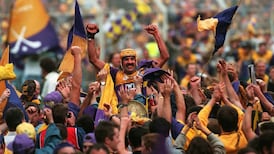Before the conclusion of its first year’s trial, there had been great focus on the All-Ireland football quarter-final format from the perspective of it contributing to the creation of a self-perpetuating elite.
That will remain to be seen but last weekend, as the pairings for this year’s semi-finals emerged, it was widely pointed out that the four teams are the same counties that filled the top four places in Division One of the AFL.
Arguably, the genesis of the game’s current elite dates back to when the GAA decided to make the league a strictly hierarchical structure, with eight-team divisions from one to four.
Previously there had been a 16-team top tier, randomly arranged into two pools.
The decision to move to a more vertical format came in 2006 even though the change was only implemented in 2008 in order to give counties time to improve their status in the following season’s competition.
The backdrop to the decision, which ushered in an era of close alignment between league and championship, was a proposal from Football Competitions Review Task Group.
There had been concerns expressed about the league. Then president Nickey Brennan apologised to sponsors for the poor crowds at matches in the spring. A year later in 2007 the GAA's then financial director Tom Ryan – now DG of the association – warned about the dangers of declining gate receipts in the league.
The task force idea was to “ensure an extremely competitive league in all four divisions” and achieve balanced groupings by addressing “the unbalanced sections which can arise in 16 team divisions”.
It would also give weaker counties the opportunity to “experience success at their own level and to progress on a gradual basis” and reduce the problem for counties of finding “the step-up from Division Two to Division One too sudden and, as a result, too demanding”.
Wicklow’s Kevin O’Brien was a member of the task group, his background as an eminent footballer – an All-Ireland club medallist with Baltinglass and his county’s first All Star – and in more recent times a senior selector, giving him an insight into the difficulties of a county in the lower divisions.
He says the league is a better competition than the championship as a result of the changes but worries about players losing interest in representing counties like his own because of the lack of prospects.
“The league should nearly be the championship because you’re playing at your own level and if you do improve, you go up to another level. Should Wicklow be playing at the top level? You could be slated for saying it because players and everyone love being in the Leinster championship but there have been some very, very heavy defeats.
Realistic ambitions
“Does that keep players around? Why do so many players from weaker counties head off on J1s? They just don’t see the gold at the end of the rainbow. When they can’t have realistic ambitions, of course it affects their commitment. Everyone wants a piece of the big day and if it’s out of their reach, you’re in trouble.”
The establishment of a strict hierarchy in the football league has impacted on the championship in the past 10 years. No team from outside Division One has won the All-Ireland and of the 20 finalists, just three had played their league season in Division Two.
More strikingly, seven of the 10 All-Ireland champions since 2008 had finished in the top two places in Division One.
O’Brien sees it as less an exercise in elitism as a reflection of reality. He would like to see graded championships introduced although he concedes it’s not universally popular among players. He has however found an appetite for it amongst those with long and hard years in the system.
The 2006 task group also proposed at the time the controversial plan to divert Division 4 teams into a tiered competition, the Tommy Murphy Cup, instead of the qualifiers when they lost in their provinces.
According to O'Brien the key to a tiered championship is to hold out the incentive of getting a crack at the Sam Maguire, much as the McDonagh Cup finalists in hurling played preliminary quarter-finals against the third-placed teams in Leinster and Munster.
“It would give teams the opportunity to come through as a wild card. There has to be an incentive. The Tommy Murphy was good at the time but there was nothing at the end of it other than a final in Croke Park at 12 o’clock with the seagulls and the pigeons.”













